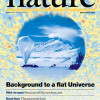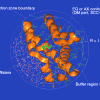Science News
Are the Digits of Pi Random?
David H. Bailey, chief technologist of the Department of Energy's National Energy Research Scientific Computing Center (NERSC) at Lawrence Berkeley National Laboratory, and his colleague Richard Crandall, director of the Center for Advanced Computation at Reed College, Portland, Oregon, have taken a major step toward answering the age-old question of whether the digits of pi and other math constants are "random." Their results are reported in the Summer 2001 issue of Experimental Mathematics. Read More »
A Lucky Catch: The Oldest, Most Distant Type Ia Supernova Confirmed by Supercomputer Analysis at NERSC
An exploding star dubbed SN 1997ff, caught once on purpose and twice by accident by NASA's Hubble Space Telescope, is the oldest and most distant Type Ia supernova ever seen, according to a recent analysis by the Department of Energy's National Energy Research Scientific Computing Center (NERSC) at Lawrence Berkeley National Laboratory. Read More »
BOOMERANG Antarctic Balloon Flight Sees a Flat Universe
On April 26, 2000, the international BOOMERANG consortium led by Andrew Lange of the California Institute of Technology and Paolo de Bernardis of Università de Roma, "La Sapienza," announced results of the most detailed measurement yet made of the cosmic microwave background radiation (CMB). Read More »
An Algorithm for the Ages
NERSC Chief Technologist David Bailey tooled a classical algorithm to run on supercomputers to help scientists discover new facts in mathematics and physics. Read More »
Solved at Last: A Fundamental Problem of Quantum Physics
For over half a century, theorists have tried and failed to provide a complete solution to scattering in a quantum system of three charged particles, one of the most fundamental phenomena in atomic physics. Such interactions are everywhere; ionization by electron impact, for example, is responsible for the glow of fluorescent lights and for the ion beams that engrave silicon chips. Read More »
BOOMERanG Analysis Finds Flat Universe
Newly released data from the 1997 North American test flight of BOOMERanG, which mapped anisotropies in the cosmic microwave background radiation (CMB) in a narrow strip of sky, show a pronounced peak in the CMB "power spectrum" at an angular scale of about one degree, strong evidence that the universe is flat. Analyzed at the Department of Energy's National Energy Research Scientific Computing Center (NERSC) at Lawrence Berkeley National Laboratory, the new… Read More »
New Biological Database Seeks Out Products of Alternative Gene Splicing
In its first half year of operation, a new database that identifies clusters of proteins arising from alternative gene splicing has received more than 35,000 requests from researchers in genetics and cell and developmental biology around the world. Read More »
NERSC and the Fate of the Universe
When the National Energy Research Scientific Computing Center (NERSC) moved to Berkeley Lab in 1996, a computational science program was created to encourage collaborations between physical and computer scientists. The Supernova Cosmology Project's work was one of the first projects funded; it demonstrates how high-performance computing can accelerate scientific discovery. Read More »
A Flaw in the Law
Turbulence is a primal force that can be seen all around us, from the scudding of clouds to the frothing of the sea, from the wrinkling of flames to the swirling of leaves. It is especially important to the study of aerodynamics, in which correctly calculating the effects of turbulence can determine whether or not an airplane remains aloft. Since 1938, the standard equation presented in aerodynamics and engineering textbooks for calculating the forces exerted on a solid object by turbulence has… Read More »
Powerful Computers Advance Fusion Research at the Princeton Plasma Physics Laboratory
Scientists at the U.S. Department of Energy's (DOE) Princeton Plasma Physics Laboratory (PPPL) report a major advance in the computer modeling of fusion plasmas in the September 18 edition of Science magazine. The new results were obtained utilizing the massively parallel processing (MPP) capabilities of the DOE's National Energy Research Scientific Computing Center (NERSC) at the Lawrence Berkeley National Laboratory in Berkeley, California. Read More »
Did the Big Bang Come With Strings Attached?
The power of supercomputers at the National Energy Research Scientific Computing Center (NERSC) has enabled Julian Borrill of the Department of Energy’s Lawrence Berkeley National Laboratory to model, in striking detail, a possible state of the universe only a hundred billionth of a trillionth of a trillionth of a second after the Big Bang. Read More »
Quantum Dot Simulations From T3E Make Journal Cover
Results of million-atom Quantum Dot simulations performed on the Cray T3E at NERSC by Alex Zunger's group at the National Renewable Energy Laboratory in Golden, Colo., will appear on the cover of the February issue of the Materials Research Society Bulletin. Read More »
Berkeley Researchers Eliminate One Theory in Mystery of Missing Xenon, but Find New Clues About Element's Behavior
Scientists at Ernest Orlando Lawrence Berkeley National Laboratory and the University of California, Berkeley, looking into the "mystery of the missing xenon" have found strong evidence against one leading theory and, along the way, discovered new information about the behavior of the element. Read More »
Protein Dynamics and Biocatalysis
Investigators: P. A. Bash, Northwestern University Medical School and M. Karplus, Harvard University Research Objectives A guiding principle of molecular biology is that the structure of a biomolecule defines its function. This principle is especially true in the case of the protein molecules known as enzymes, which serve as highly specific and extraordinarily efficient catalysts of biochemical reactions. Despite the growing availability of the atomic structures of enzymes, details of the… Read More »
Theoretical Study on Catalysis by Protein Enzymes and Ribozyme
Principal Investigator: Martin Karplus, Harvard University Research Objectives The goal of this project is to develop a greater understanding of the mechanisms involved in enzyme catalysis and related protein functions. We are studying two types of enzymes: proteins and a nucleic acid (hammerhead ribozyme). Computational Approach For active-site models in the gas phase, ab initio or density functional (DFT) calculations are used. A few calculations with continuum dieletric models are… Read More »
Theoretical Study on Catalysis by Protein Enzymes, Ribosome, and Molecular Motors
Principal Investigator: Martin Karplus, Harvard University Research Objectives This project's goal is to develop a greater understanding of the mechanisms involved in enzyme catalysis and related protein functions. We are studying the protein enzymes chorismate mutase, flavoxireductase, and aminopeptidase, and a nucleic acid enzyme, the hammerhead ribosome. We are also studying another class of enzymes known as molecular motors, which play important roles in bioenergy transduction and gene… Read More »

















